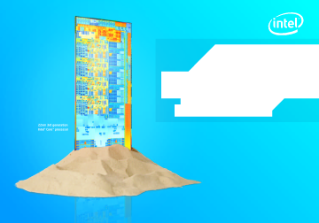How Intel Makes Chips: Transistors to Transformations
How Intel Makes Chips: Transistors to Transformations
REVOLUTIONARY
For decades, Intel’s research and development, advanced silicon chips, and manufacturing have brought together the best of computing, communications, and consumer electronics to enable valuable benefits from technology.
Intel continues to introduce new process technologies that deliver more energy-efficient,
secure, and higher-performance products, which are then designed into your increasingly connected, smarter devices.
MOORE’S LAW
According to Moore’s Law, the number of transistors on a chip roughly doubles every couple of years. As a result, the transistor scale gets smaller and smaller. As the transistor count climbs, so does the ability to integrate more capabilities onto a chip and increase device complexity.
The cumulative impact of these spiraling increases in capabilities enables today’s mobile devices, fuels the increasingly Internet-connected and information-rich digital experiences we seek, and powers industries and our global economy.
Delivering Moore’s Law requires numerous innovations. Intel’s world-first, advanced transistor design introductions include strained silicon (2003), 45nm with high-k/metal gate silicon technology (2007), followed by the 32nm 2nd generation high-k/metal gate silicon technology (2009). Recently, Intel introduced another radical design change—22nm 3-D Tri-Gate transistors (2011), which entered high-volume production in 2012.
YOUR WORLD CONNECTED
“Our vision is very simple: if it consumes electricity, it’s going to end up computing, and if it’s computing, it will be connected to the Internet,” stated Kirk B. Skaugen, Intel Vice President and General Manager of the PC Client Group. He was describing server cloud computing capabilities and connected device growth expected within the next decade at the Web 2.0 Summit in November 2011.
Forecasts call for 15 billion connected devices and over three billion connected users by 2015. The growth of global data through 2015 is expected to surpass 4.8 zettabytes per year. At these levels, each connected user will generate more than four GB of data traffic every day. That’s the equivalent of a 4-hour HD movie.
THE POWER TO TRANSFORM
From Ultrabook™ devices, data centers, and high performance computing, to applications, security, and Intel-powered smartphones and tablets, the only thing more amazing than Intel’s technology iswhat you do with it.
Read the full How Intel Makes Chips brochure.
